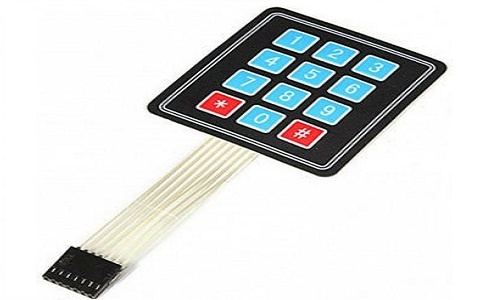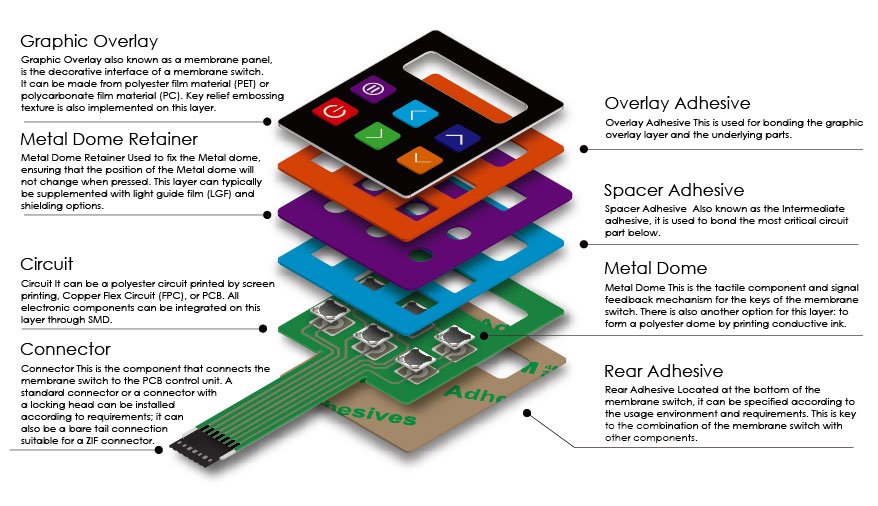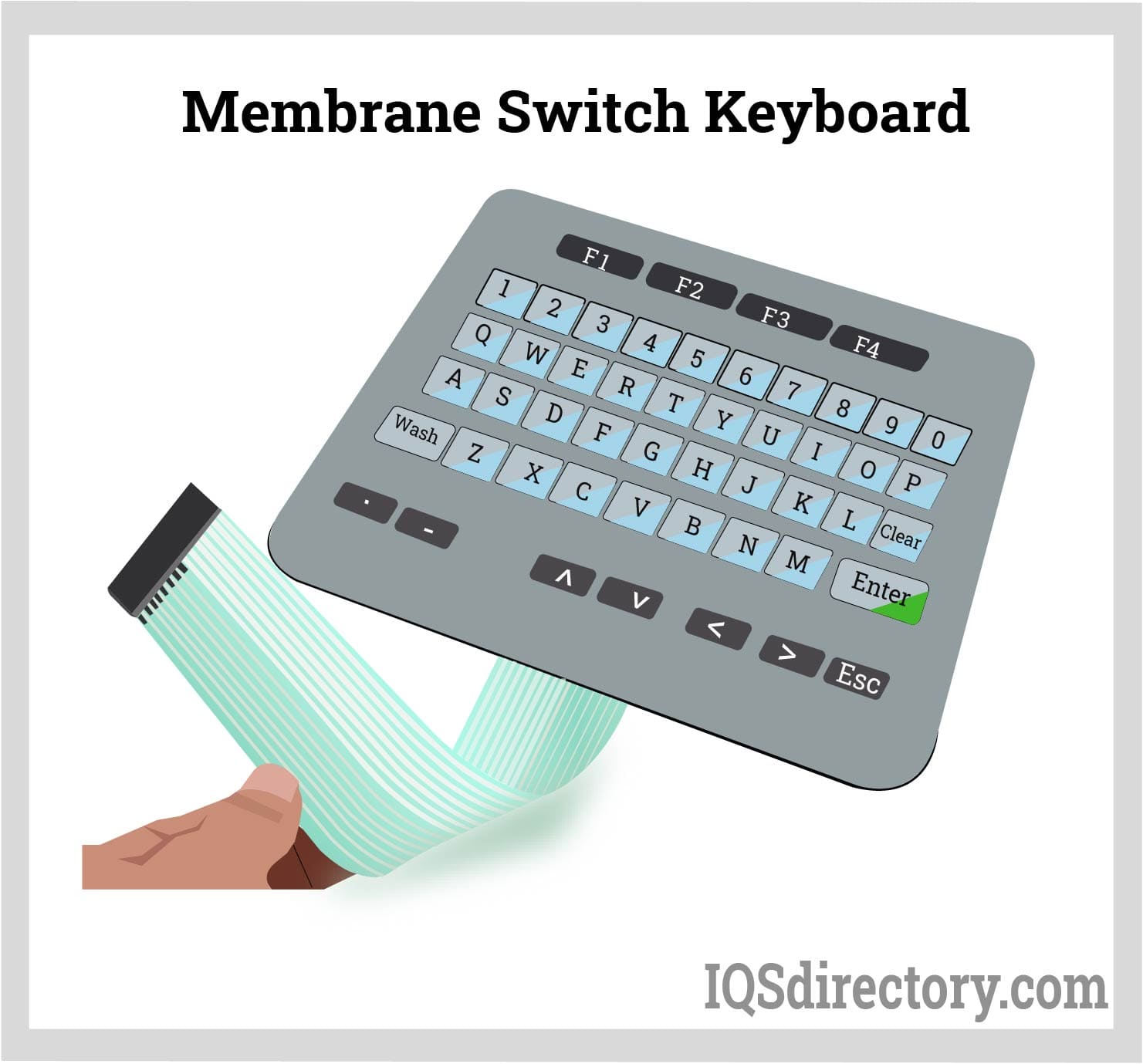Design tips for maximizing membrane switch usability
The Production Process Behind Membrane Change: What You Required to Know
The production process behind membrane layer switches combines careful design, material option, and quality assurance. It starts with understanding the details of membrane button style and advances through different stages, including material options and printing techniques. Each stage plays a vital duty in guaranteeing functionality and sturdiness. Nonetheless, the intricacies of layer building and the strenuous screening criteria may reveal understandings that are not instantly evident. What exists past these foundational aspects?
Recognizing Membrane Layer Switch Style
Although membrane layer switches may show up simple in the beginning glimpse, their style entails intricate factors to consider that assure functionality and sturdiness. The design procedure starts with a thorough understanding of user requirements, including the interface's intended application and environmental factors. Comfort designs is an essential element, as the layout must facilitate ease of use while ensuring that responsive responses fulfills individual expectations.Moreover, the layering of elements, such as graphic overlays, adhesive layers, and conductive traces, must be precisely crafted. membrane switch. This layered setup not only influences the button's responsiveness however likewise impacts its durability. Interest is provided to the sealing techniques used to protect against dampness and dirt, which might jeopardize performance. In addition, style considerations reach appearances, where color pattern and aesthetic clarity enhance individual experience. Eventually, the design of membrane layer changes balances capability, individual experience, and sturdiness, making sure that they satisfy the demands of numerous applications efficiently
Materials Utilized in Membrane Change Manufacturing
When selecting products for membrane layer button production, it is important to ponder both performance and longevity. The main materials include polyester and polycarbonate films, which supply versatility and stamina. These movies are often covered with adhesive to guarantee correct bonding to substrates. Conductive inks, usually composed of silver or carbon, are essential for producing electrical connections within the button, enabling dependable operation.Additionally, a protective layer, such as a tough layer, is frequently put on improve scrape resistance and longevity. The selection of backing product, such as acrylic or foam, can substantially affect the button's responsive feel and general customer experience. Various environmental aspects, consisting of temperature level and humidity, ought to direct product choice to ensure peak efficiency in details applications. Ultimately, the best combination of materials adds to the membrane layer button's capability and life expectancy, making notified options crucial for manufacturers.
The Printing Process: Creating Graphics and Text
The printing procedure in membrane button production plays a significant role in producing top quality graphics and text. Various graphic style strategies are used to assure aesthetic charm and functionality, while mindful ink option techniques are necessary for resilience and performance. Understanding these components is basic for attaining finest cause membrane layer button layout.
Graphic Layout Techniques
Graphic style methods play an important function in the printing procedure of membrane layer buttons, as they define how graphics and text will eventually appear on the end product. Effective graphic design entails the strategic use shades, designs, and typefaces to improve readability and visual appeal. Designers commonly make use of vector graphics for scalability, guaranteeing that images stay sharp at various sizes. Additionally, interest to contrast and positioning is important, as it influences individual communication and visual high quality. The incorporation of branding aspects, such as logos, should be taken care of with like preserve brand stability. In general, thoughtful visuals design strategies add considerably to the performance and attractiveness of membrane switches, affecting user experience and product efficiency.
Ink Option Approaches
Choosing the appropriate ink is necessary for accomplishing the desired aesthetic quality and sturdiness in membrane button manufacturing. Numerous ink types are utilized, consisting of solvent-based, water-based, and UV-curable inks. Each type offers distinctive attributes, such as resistance, adhesion, and flexibility to environmental elements. Solvent-based inks are commonly preferred for their sturdiness and dynamic shades, while water-based inks are more environmentally pleasant yet might have restrictions in attachment. UV-curable inks give rapid curing and durable efficiency. Additionally, shade matching methods assure that the chosen inks line up with design specifications. Ultimately, the choice of ink should consider factors such as application method, substratum compatibility, and end-use needs to accomplish exceptional results in membrane layer button graphics and text.
Layer Building And Construction and Setting Up

Material Choice Process
A cautious option of products is necessary in the production procedure of membrane layer buttons, as it straight affects functionality and sturdiness. The main materials utilized consist of polyester, polycarbonate, and numerous conductive inks. Polyester is often favored for its outstanding resistance to chemicals and abrasion, making it suitable for severe environments. Polycarbonate, on the other hand, provides superior clarity and effect resistance, which is valuable for applications calling for presence and effectiveness. Conductive inks, normally made up of silver or carbon, are crucial for producing reputable electrical pathways. Additionally, the option of adhesive materials influences the total stability of the switch - membrane switch. Evaluating factors such as ecological direct exposure, responsive responses, and aesthetic demands guides manufacturers in picking the most effective materials for their specific applications
Layer Attachment Methods
Adhering layers in membrane button building is a vital procedure that ensures functionality and long life. Different adhesion techniques are used to protect perfect bonding in between layers, which usually include the usage of adhesives, warm, and stress. Pressure-sensitive adhesives (PSAs) are frequently utilized for their simplicity of application and immediate bonding capacities. Additionally, thermal bonding strategies can YOURURL.com be applied, where warmth is utilized to turn on sticky homes, safeguarding a strong bond. The choice of attachment method mainly depends on the products involved and the particular application needs of the membrane button. Proper positioning and uniform application of adhesives are necessary to protect against flaws, securing the switch runs effectively throughout its designated life-span.
Quality Assurance Actions
Guaranteeing high quality control throughout the layer construction and assembly of membrane layer buttons is important for preserving efficiency and dependability. This procedure typically includes a number of critical steps, including detailed inspections at each stage of production. Producers make use of innovative screening methods, such as peel tests and adhesion evaluations, to confirm the stability of layer bonds. In addition, aesthetic examinations are carried out to recognize any kind of issues in printing or product inconsistencies. Environmental conditions, such as temperature and humidity, are carefully monitored to guarantee suitable treating and weblink bond. Regular calibration of equipment aids keep specific production requirements. By executing these quality assurance steps, producers can greatly reduce the danger of item failing, ensuring that the final membrane switches over fulfill the needed specs and customer assumptions.
Checking and Top Quality Control Measures

Technologies in Membrane Layer Switch Technology
As innovations in innovation continue to evolve, membrane layer buttons are benefiting from cutting-edge advancements that enhance their capability and individual experience. One noteworthy technology is the combination of capacitive touch modern technology, which allows for more receptive and instinctive look at these guys interface. This shift not only boosts aesthetic appeals but likewise decreases mechanical deterioration, expanding the lifespan of the switches.Additionally, improvements in visuals overlay materials have actually led to improved durability and resistance to ecological factors such as wetness and UV light. These products now supply enhanced clearness and illumination, further raising the aesthetic appeal.Furthermore, the consolidation of wise technology is transforming membrane layer switches over into interactive control board, enabling connectivity with IoT tools. This connection fosters a smooth customer experience, paving the way for applications in different sectors, from healthcare to consumer electronic devices. Jointly, these innovations setting membrane layer switches over as crucial elements in modern-day tool design.
Frequently Asked Questions
How much time Does the Membrane Change Production Refine Take?
The period of the membrane layer button production procedure can differ considerably. Elements such as complexity, materials utilized, and manufacturing quantity impact timelines, with normal manufacturing varying from a couple of days to a number of weeks for conclusion.
What Are the Typical Applications for Membrane Switches?
Membrane switches are generally used in numerous sectors, consisting of auto controls, house devices, clinical gadgets, and consumer electronics (membrane switch). Their convenience and longevity make them excellent for applications calling for straightforward user interfaces and trustworthy efficiency in diverse environments
Can Membrane Switches Over Be Custom-made for Certain Requirements?

What Is the Lifespan of a Common Membrane Layer Switch Over?
The lifespan of a typical membrane layer button differs, but generally, it ranges from 1 to 5 million cycles. Elements such as usage, atmosphere, and worldly high quality substantially affect durability and overall performance in time.

Are Membrane Layer Switches Over Ecologically Friendly?
The environmental friendliness of membrane layer switches over differs. Some materials used might not be recyclable, while others can be green. The total effect depends upon manufacturing products and methods, necessitating mindful factor to consider during selection and disposal. The production process behind membrane switches over combines cautious style, product option, and quality control. It starts with recognizing the details of membrane layer switch layout and advances through numerous stages, including material choices and printing strategies. When choosing products for membrane layer switch production, it is vital to contemplate both efficiency and resilience. A mindful choice of materials is necessary in the manufacturing procedure of membrane layer buttons, as it directly affects functionality and longevity. The option of adhesion technique largely depends on the products entailed and the particular application needs of the membrane button.